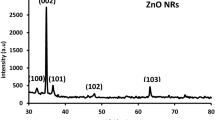Abstract
Highly oriented rutile titanium dioxide (TiO2) nanorod arrays were grown on fluorine-doped tin oxide (FTO) substrate using a hydrothermal method. X-ray diffraction, Raman spectra, field emission-scanning electron microscopy, and ultraviolet-visible spectroscopy were conducted to determine the structural, morphological, and optical properties of the sample. The synthesized TiO2 nanorod arrays exhibited tetragonal rutile structure. The photocurrent analysis was done by using photoelectrochemical method where different bias voltage (0 V to 0.9 V) was applied. The photocurrent value shows acceptable difference with increasing bias voltage. The TiO2 nanorod array (TNAs) UV sensors show high responsivity as indicated by the fast rise and decay time of the photocurrent of less than 1 s with every bias voltage applied.










Similar content being viewed by others
References
Buzby, S., et al.: Visible light photocatalysis with nitrogen-doped titanium dioxide nanoparticles prepared by plasma assisted chemical vapor deposition. J Vac Sci Technol B Microelectron Nanom Struct. 24(3), 1210–1214 (2006)
Xiong, J., et al.: Efficient organic photovoltaics using solution-processed, annealing-free TiO2 nanocrystalline particles as an interface modification layer. Org. Electron. 17, 253–261 (2015)
Okuya, M., et al.: Porous TiO2 thin films prepared by spray pyrolysis deposition (SPD) technique and their application to UV sensors. Solid State Ionics. 172(1–4 SPEC. ISS.), 527–531 (2004)
Perillo, P.M., Rodríguez, D.F.: Sensors and actuators B: chemical short communication A room temperature chloroform sensor using TiO 2 nanotubes. Sensors Actuators B Chem. 193, 263–266 (2014)
Burda, C., Chen, X., Narayanan, R., El-sayed, M.A.: Chemistry and properties of nanocrystals of different shapes. Chem. Rev. 105(4), 1025–1102 (2005)
Chen, X., Mao, S.S.: Titanium dioxide nanomaterials: synthesis, properties, modifications, and applications. Chem. Rev. 107, 2891–2959 (2007)
Lidija, M.T., Bojan, M.A., Paula, J.M., Olivera, B., Fernando, R.: Precursor particle size as the key parameter for isothermal tuning of morphology from nanofibers to nanotubes in the Na2-xHxTinO2n+1 system through hydrothermal alkali treatment of rutile mineral sand. Am. Chem. Soc. 9(5), 2152–2158 (2009)
Zhou,W., Liu, X., Cui, J., Liu, D., Li, J., Jiang, H., Wang, J., Liu, H.: Control synthesis of rutile TiO2 microspheres, nanoflowers, nanotrees and nanobelts via acidhydrothermal method and their optical properties. CrystEngComm, 13(14), 4557–4565 (2011)
Selman, A.M., Hassan, Z.: Highly sensitive fast-response UV photodiode fabricated from rutile TiO2 nanorod array on silicon substrate. Sensors Actuators A Phys. 221, 15–21 (Jan. 2015)
Zu, X., et al.: Self-powered UV photodetector based on heterostructured TiO2 nanowire arrays and polyaniline nanoflower arrays. Synth. Met. 200, 58–65 (2015)
Ahmad, M.K., et al.: Raman investigation of rutile-phased TiO2 nanorods/nanoflowers with various reaction times using one step hydrothermal method. J. Mater. Sci. Mater. Electron. 27(8), 7920–7926 (2016)
J. Kim et al.: Ga-doped ZnO transparent electrodes with TiO2 blocking layer/nanoparticles for dye-sensitized solar cells, pp. 2–5, 2012
Zhou, J.J., Wang, S.Y., Gunasekaran, S.: Preparation and characterization of whey protein film incorporated with TiO2 nanoparticles. J. Food Sci. 74(7), 50–56 (2009)
Kuriechen, S.K., Murugesan, S., Raj, S.P.: Mineralization of azo dye using combined photo-Fenton and photocatalytic processes under visible light. J. Catal. 2013, 1–6 (2013)
Yang, G., Jiang, Z., Shi, H., Xiao, T., Yan, Z.: Preparation of highly visible-light active N-doped TiO2 photocatalyst. J. Mater. Chem. 20(25), 5301–5309 (2010)
Tian, J., et al.: Enhanced photocatalytic performances of CeO2/TiO2 nanobelt heterostructures. Small. 9(22), 3864–3872 (2013)
Cao, C., Hu, C., Wang, X., Wang, S., Tian, Y., Zhang, H.: UV sensor based on TiO2 nanorod arrays on FTO thin film. Sensors Actuators B Chem. 156(1), 114–119 (Aug. 2011)
R. van de Krol and Michael Grätzel, Principles of Photoelectrochemical Cells, vol. 102. Springer US, 2012
Bard, A.J.: Design of semiconductor photoelectrochemical systems for solar energy conversion. J. Phys. Chem. C. 86(May), 172–177 (1982)
Li, H., Zheng, L., Shu, S., Cheng, H., Yang, Y.: Morphology control of anodic TiO2 nanomaterials via cold work pretreatment of Ti foils. J. Electrochem. Soc. 158(10), 346–351 (2011)
Tian, Y., Hu, C., He, X., Cao, C., Huang, G., Zhang, K.: Chemical titania nanotube arrays for light sensor and UV photometer. Sensors Actuators B Chem. 144, 203–207 (2010)
Selman, A.M., Hassan, Z.: Effects of variations in precursor concentration on the growth of rutile TiO2 nanorods on Si substrate with fabricated fast-response metal–semiconductor–metal UV detector. Opt Mater (Amst). 44, 37–47 (Jun. 2015)
Xie, Y., et al.: A self-powered UV photodetector based on TiO2 nanorod arrays. Nanoscale Res. Lett. 8(188), 1–6 (2013)
Cao, C., Hu, C., Shen, W., Wang, S., Song, S., Wang, M.: Improving photoelectrochemical performance by building Fe2O3 heterostructure on TiO2 nanorod arrays. Mater. Res. Bull. 70(3), 155–162 (2015)
Funding
Financial support was provided by the Ministry of Education (MOE) Malaysia (Vot 1213), Microelectronic and Nanotechnology-Shamsuddin Research Centre (MiNT-SRC), and Universiti Tun Hussein Onn Malaysia (UTHM) using Vot STG U347.
Author information
Authors and Affiliations
Corresponding author
Additional information
Publisher’s note
Springer Nature remains neutral with regard to jurisdictional claims in published maps and institutional affiliations.
Rights and permissions
About this article
Cite this article
Mokhtar, S.M., Ahmad, M.K., Nafarizal, N. et al. High responsivity of ultraviolet sensor-based rutile-phased TiO2 nanorod arrays using different bias voltage. J Aust Ceram Soc 56, 461–468 (2020). https://doi.org/10.1007/s41779-019-00350-6
Received:
Revised:
Accepted:
Published:
Issue Date:
DOI: https://doi.org/10.1007/s41779-019-00350-6




